Business Administration Report on Problem Solving and Improvement
VerifiedAdded on 2020/11/12
|13
|4265
|281
Report
AI Summary
This report delves into the realm of business administration, examining crucial aspects of problem-solving and continuous improvement. It begins by outlining various problem-solving techniques, such as brainstorming and abstraction, and then explores organizational and legal constraints that can impede effective solutions. The report emphasizes the role of stakeholders in the problem-solving process and details the steps involved in business decision-making, including gathering information, identifying alternatives, and evaluating evidence. It further discusses the implications of implementing recommendations, particularly concerning quality and time management, and highlights the purpose and benefits of continuous improvement, along with different techniques and models like Six Sigma and Kaizen. The report also addresses the importance of customer feedback and other stakeholder input, analyzing the nature, causes, and implications of quality-related problems, and proposing possible courses of action. Overall, the report provides a comprehensive overview of problem-solving and continuous improvement within a business context.
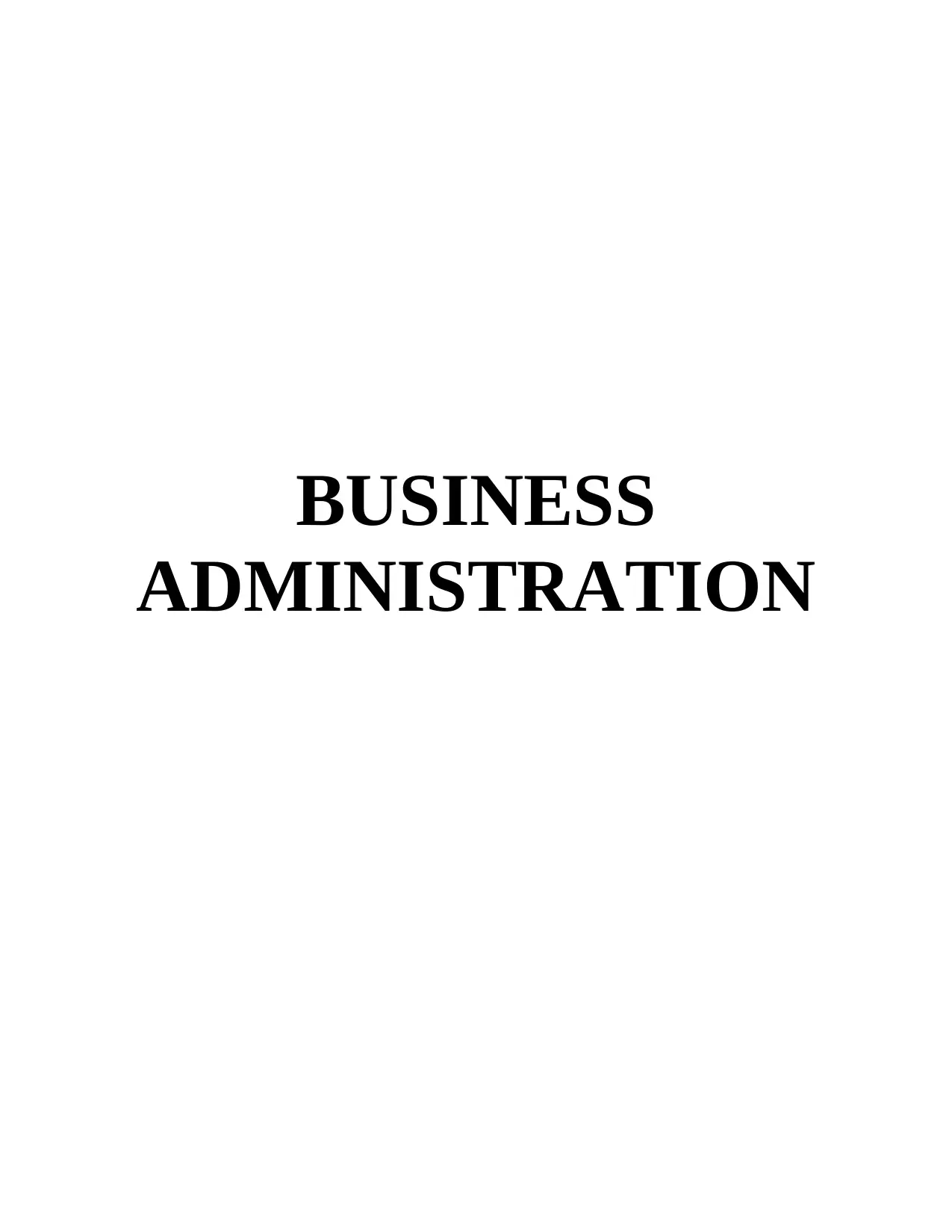
BUSINESS
ADMINISTRATION
ADMINISTRATION
Paraphrase This Document
Need a fresh take? Get an instant paraphrase of this document with our AI Paraphraser
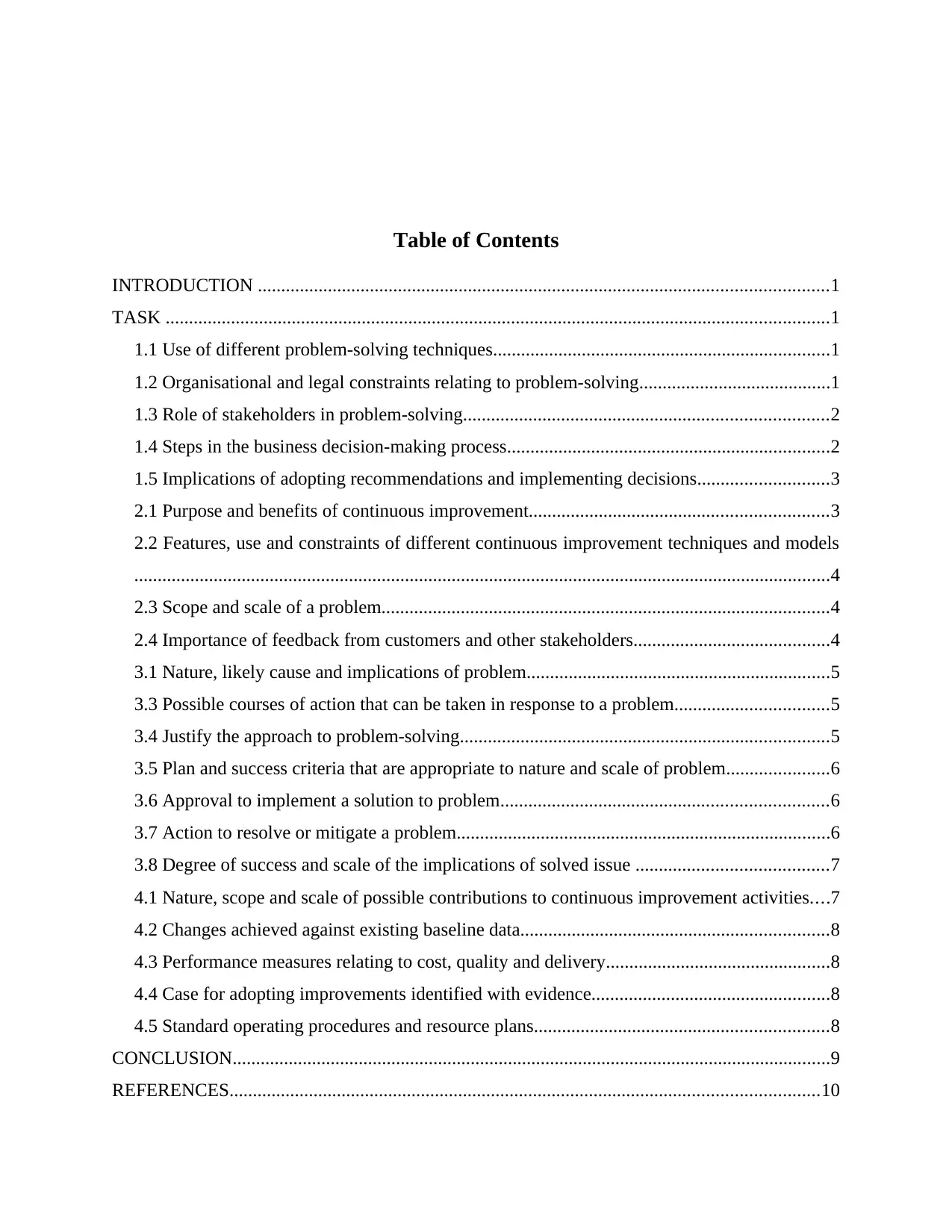
Table of Contents
INTRODUCTION ..........................................................................................................................1
TASK ..............................................................................................................................................1
1.1 Use of different problem-solving techniques........................................................................1
1.2 Organisational and legal constraints relating to problem-solving.........................................1
1.3 Role of stakeholders in problem-solving..............................................................................2
1.4 Steps in the business decision-making process.....................................................................2
1.5 Implications of adopting recommendations and implementing decisions............................3
2.1 Purpose and benefits of continuous improvement................................................................3
2.2 Features, use and constraints of different continuous improvement techniques and models
.....................................................................................................................................................4
2.3 Scope and scale of a problem................................................................................................4
2.4 Importance of feedback from customers and other stakeholders..........................................4
3.1 Nature, likely cause and implications of problem.................................................................5
3.3 Possible courses of action that can be taken in response to a problem.................................5
3.4 Justify the approach to problem-solving...............................................................................5
3.5 Plan and success criteria that are appropriate to nature and scale of problem......................6
3.6 Approval to implement a solution to problem......................................................................6
3.7 Action to resolve or mitigate a problem................................................................................6
3.8 Degree of success and scale of the implications of solved issue .........................................7
4.1 Nature, scope and scale of possible contributions to continuous improvement activities....7
4.2 Changes achieved against existing baseline data..................................................................8
4.3 Performance measures relating to cost, quality and delivery................................................8
4.4 Case for adopting improvements identified with evidence...................................................8
4.5 Standard operating procedures and resource plans...............................................................8
CONCLUSION................................................................................................................................9
REFERENCES..............................................................................................................................10
INTRODUCTION ..........................................................................................................................1
TASK ..............................................................................................................................................1
1.1 Use of different problem-solving techniques........................................................................1
1.2 Organisational and legal constraints relating to problem-solving.........................................1
1.3 Role of stakeholders in problem-solving..............................................................................2
1.4 Steps in the business decision-making process.....................................................................2
1.5 Implications of adopting recommendations and implementing decisions............................3
2.1 Purpose and benefits of continuous improvement................................................................3
2.2 Features, use and constraints of different continuous improvement techniques and models
.....................................................................................................................................................4
2.3 Scope and scale of a problem................................................................................................4
2.4 Importance of feedback from customers and other stakeholders..........................................4
3.1 Nature, likely cause and implications of problem.................................................................5
3.3 Possible courses of action that can be taken in response to a problem.................................5
3.4 Justify the approach to problem-solving...............................................................................5
3.5 Plan and success criteria that are appropriate to nature and scale of problem......................6
3.6 Approval to implement a solution to problem......................................................................6
3.7 Action to resolve or mitigate a problem................................................................................6
3.8 Degree of success and scale of the implications of solved issue .........................................7
4.1 Nature, scope and scale of possible contributions to continuous improvement activities....7
4.2 Changes achieved against existing baseline data..................................................................8
4.3 Performance measures relating to cost, quality and delivery................................................8
4.4 Case for adopting improvements identified with evidence...................................................8
4.5 Standard operating procedures and resource plans...............................................................8
CONCLUSION................................................................................................................................9
REFERENCES..............................................................................................................................10
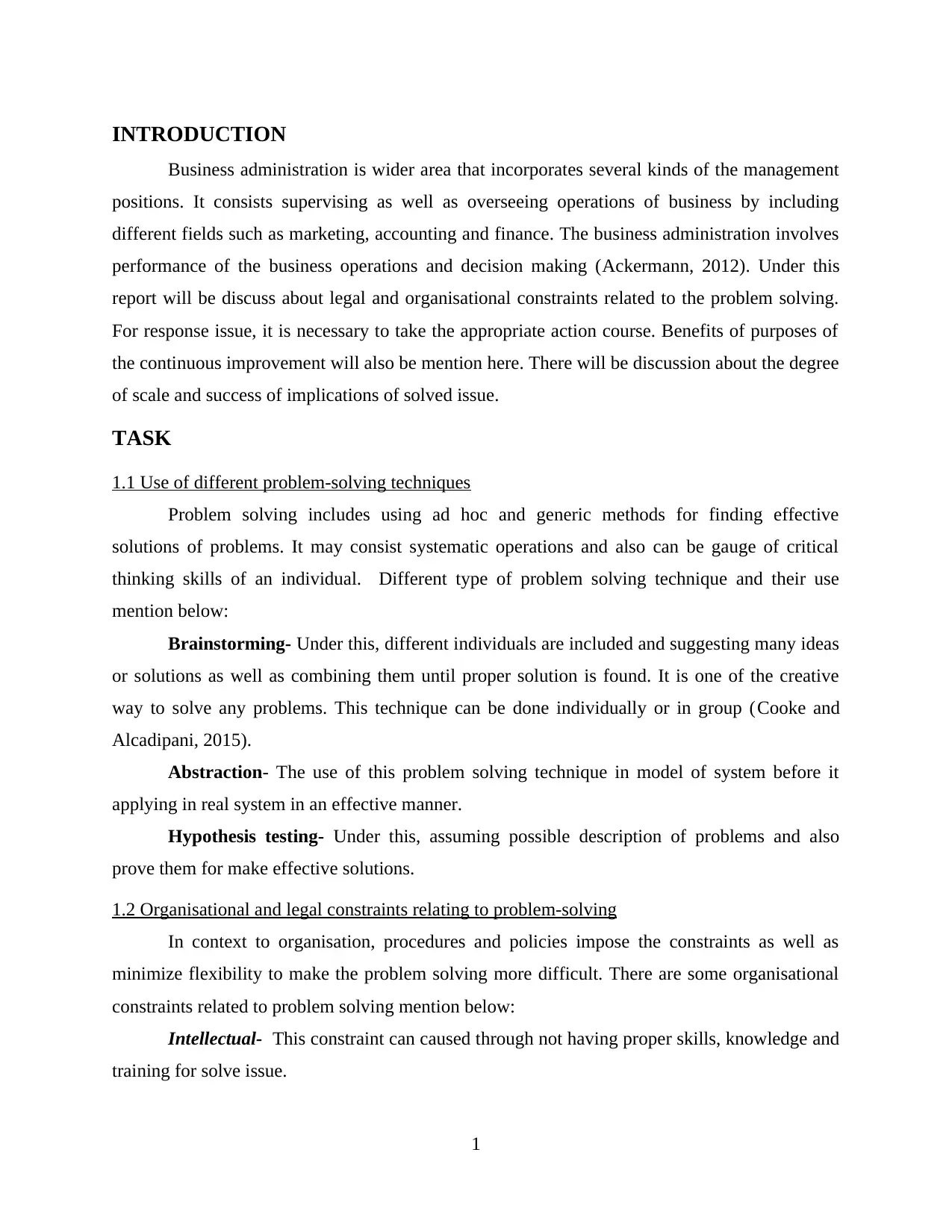
INTRODUCTION
Business administration is wider area that incorporates several kinds of the management
positions. It consists supervising as well as overseeing operations of business by including
different fields such as marketing, accounting and finance. The business administration involves
performance of the business operations and decision making (Ackermann, 2012). Under this
report will be discuss about legal and organisational constraints related to the problem solving.
For response issue, it is necessary to take the appropriate action course. Benefits of purposes of
the continuous improvement will also be mention here. There will be discussion about the degree
of scale and success of implications of solved issue.
TASK
1.1 Use of different problem-solving techniques
Problem solving includes using ad hoc and generic methods for finding effective
solutions of problems. It may consist systematic operations and also can be gauge of critical
thinking skills of an individual. Different type of problem solving technique and their use
mention below:
Brainstorming- Under this, different individuals are included and suggesting many ideas
or solutions as well as combining them until proper solution is found. It is one of the creative
way to solve any problems. This technique can be done individually or in group (Cooke and
Alcadipani, 2015).
Abstraction- The use of this problem solving technique in model of system before it
applying in real system in an effective manner.
Hypothesis testing- Under this, assuming possible description of problems and also
prove them for make effective solutions.
1.2 Organisational and legal constraints relating to problem-solving
In context to organisation, procedures and policies impose the constraints as well as
minimize flexibility to make the problem solving more difficult. There are some organisational
constraints related to problem solving mention below:
Intellectual- This constraint can caused through not having proper skills, knowledge and
training for solve issue.
1
Business administration is wider area that incorporates several kinds of the management
positions. It consists supervising as well as overseeing operations of business by including
different fields such as marketing, accounting and finance. The business administration involves
performance of the business operations and decision making (Ackermann, 2012). Under this
report will be discuss about legal and organisational constraints related to the problem solving.
For response issue, it is necessary to take the appropriate action course. Benefits of purposes of
the continuous improvement will also be mention here. There will be discussion about the degree
of scale and success of implications of solved issue.
TASK
1.1 Use of different problem-solving techniques
Problem solving includes using ad hoc and generic methods for finding effective
solutions of problems. It may consist systematic operations and also can be gauge of critical
thinking skills of an individual. Different type of problem solving technique and their use
mention below:
Brainstorming- Under this, different individuals are included and suggesting many ideas
or solutions as well as combining them until proper solution is found. It is one of the creative
way to solve any problems. This technique can be done individually or in group (Cooke and
Alcadipani, 2015).
Abstraction- The use of this problem solving technique in model of system before it
applying in real system in an effective manner.
Hypothesis testing- Under this, assuming possible description of problems and also
prove them for make effective solutions.
1.2 Organisational and legal constraints relating to problem-solving
In context to organisation, procedures and policies impose the constraints as well as
minimize flexibility to make the problem solving more difficult. There are some organisational
constraints related to problem solving mention below:
Intellectual- This constraint can caused through not having proper skills, knowledge and
training for solve issue.
1
⊘ This is a preview!⊘
Do you want full access?
Subscribe today to unlock all pages.

Trusted by 1+ million students worldwide
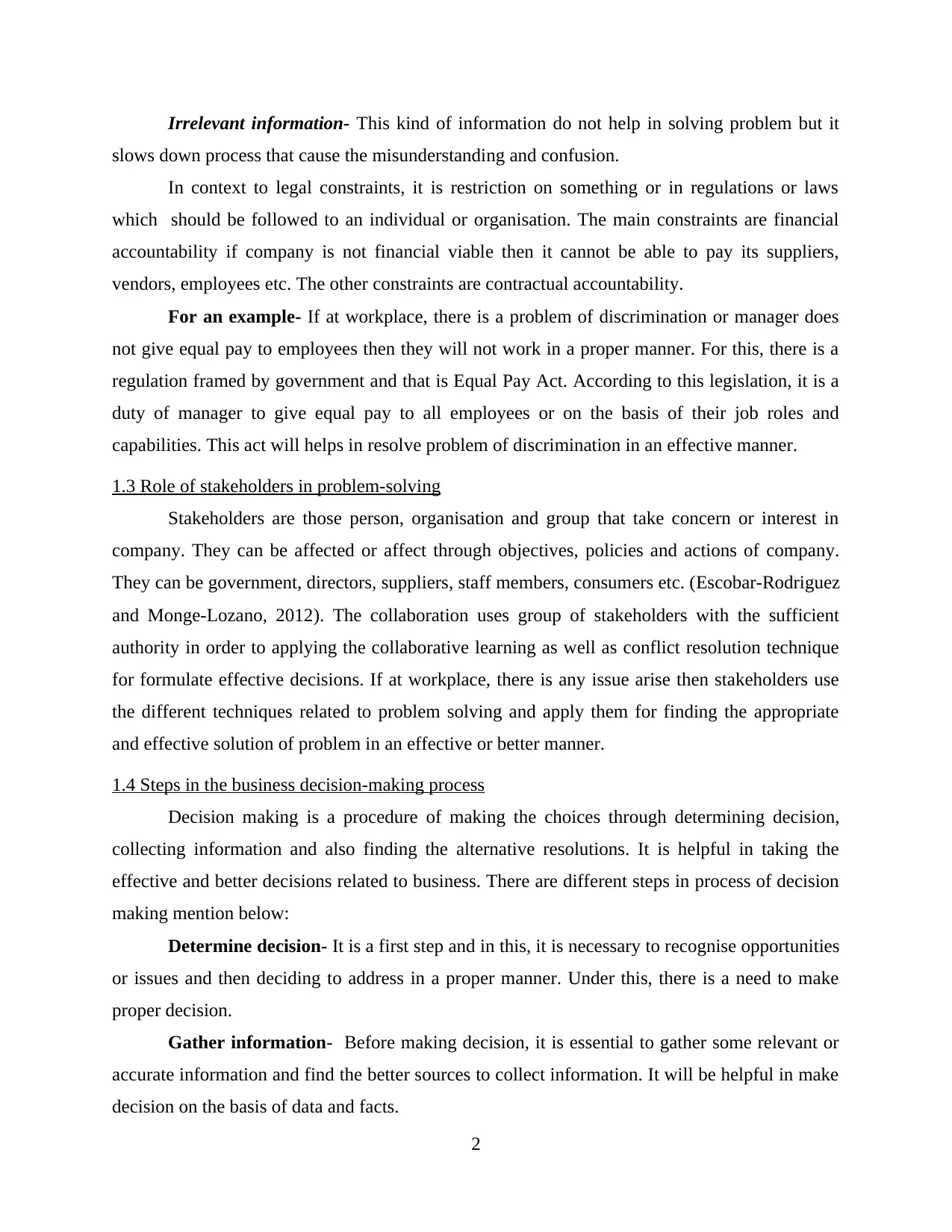
Irrelevant information- This kind of information do not help in solving problem but it
slows down process that cause the misunderstanding and confusion.
In context to legal constraints, it is restriction on something or in regulations or laws
which should be followed to an individual or organisation. The main constraints are financial
accountability if company is not financial viable then it cannot be able to pay its suppliers,
vendors, employees etc. The other constraints are contractual accountability.
For an example- If at workplace, there is a problem of discrimination or manager does
not give equal pay to employees then they will not work in a proper manner. For this, there is a
regulation framed by government and that is Equal Pay Act. According to this legislation, it is a
duty of manager to give equal pay to all employees or on the basis of their job roles and
capabilities. This act will helps in resolve problem of discrimination in an effective manner.
1.3 Role of stakeholders in problem-solving
Stakeholders are those person, organisation and group that take concern or interest in
company. They can be affected or affect through objectives, policies and actions of company.
They can be government, directors, suppliers, staff members, consumers etc. (Escobar-Rodriguez
and Monge-Lozano, 2012). The collaboration uses group of stakeholders with the sufficient
authority in order to applying the collaborative learning as well as conflict resolution technique
for formulate effective decisions. If at workplace, there is any issue arise then stakeholders use
the different techniques related to problem solving and apply them for finding the appropriate
and effective solution of problem in an effective or better manner.
1.4 Steps in the business decision-making process
Decision making is a procedure of making the choices through determining decision,
collecting information and also finding the alternative resolutions. It is helpful in taking the
effective and better decisions related to business. There are different steps in process of decision
making mention below:
Determine decision- It is a first step and in this, it is necessary to recognise opportunities
or issues and then deciding to address in a proper manner. Under this, there is a need to make
proper decision.
Gather information- Before making decision, it is essential to gather some relevant or
accurate information and find the better sources to collect information. It will be helpful in make
decision on the basis of data and facts.
2
slows down process that cause the misunderstanding and confusion.
In context to legal constraints, it is restriction on something or in regulations or laws
which should be followed to an individual or organisation. The main constraints are financial
accountability if company is not financial viable then it cannot be able to pay its suppliers,
vendors, employees etc. The other constraints are contractual accountability.
For an example- If at workplace, there is a problem of discrimination or manager does
not give equal pay to employees then they will not work in a proper manner. For this, there is a
regulation framed by government and that is Equal Pay Act. According to this legislation, it is a
duty of manager to give equal pay to all employees or on the basis of their job roles and
capabilities. This act will helps in resolve problem of discrimination in an effective manner.
1.3 Role of stakeholders in problem-solving
Stakeholders are those person, organisation and group that take concern or interest in
company. They can be affected or affect through objectives, policies and actions of company.
They can be government, directors, suppliers, staff members, consumers etc. (Escobar-Rodriguez
and Monge-Lozano, 2012). The collaboration uses group of stakeholders with the sufficient
authority in order to applying the collaborative learning as well as conflict resolution technique
for formulate effective decisions. If at workplace, there is any issue arise then stakeholders use
the different techniques related to problem solving and apply them for finding the appropriate
and effective solution of problem in an effective or better manner.
1.4 Steps in the business decision-making process
Decision making is a procedure of making the choices through determining decision,
collecting information and also finding the alternative resolutions. It is helpful in taking the
effective and better decisions related to business. There are different steps in process of decision
making mention below:
Determine decision- It is a first step and in this, it is necessary to recognise opportunities
or issues and then deciding to address in a proper manner. Under this, there is a need to make
proper decision.
Gather information- Before making decision, it is essential to gather some relevant or
accurate information and find the better sources to collect information. It will be helpful in make
decision on the basis of data and facts.
2
Paraphrase This Document
Need a fresh take? Get an instant paraphrase of this document with our AI Paraphraser

Identify alternatives- In this step, once understand about issue in proper manner, it is
necessary to determine different solutions at disposal. These options will help in making
decisions (Hakansson, 2015).
Weigh evidence- At this stage, there is a requirement to examine acceptability,
desirability and feasibility to know about the best alternative. Management of company needs to
determine cons and pros and chose an option that provide the high success chances.
Select among alternatives- There is a requirement to make decisions and also
understand the risk that is included with selected route. There is a need to select combination of
different alternatives and select the beneficial one that can help in make effective decisions.
Take action- In this step, there is a requirement to develop plan for execution., it
consists determining what resources will be needed and gain support from stakeholders.
Review decision- It is a lasts step and it evaluate decision for the effectiveness. If in case
decision is not met with determined need then it is necessary to repeat the certain steps of this
whole process in order to make new decision (Hesselbarth and Schaltegger, 2014).
1.5 Implications of adopting recommendations and implementing decisions
Under this, there are two different problems which impact on business and these are
related to time management and quality.
Quality
In context to quality, it has been recommended that organisation should use the different
techniques and tools related to quality improvement such as Six sigma, Total Quality
Management. It will help in making improvement in quality of products and in decision making.
In order to implement this recommendation, company face some problems related to money, lack
of competencies in employees to using these tools.
Time management
It has been recommended that firm should use the effective time management tool i.e.
Time Tracking Tool that helps in manage productivity of staff members effectively. The issues
which company can face in implication of recommendation are lack of knowledge about tool,
training etc.
2.1 Purpose and benefits of continuous improvement
Continuous improvement refers to ongoing efforts for making improvement in services,
processes and products. It is set of different activities which are designed to ongoing
3
necessary to determine different solutions at disposal. These options will help in making
decisions (Hakansson, 2015).
Weigh evidence- At this stage, there is a requirement to examine acceptability,
desirability and feasibility to know about the best alternative. Management of company needs to
determine cons and pros and chose an option that provide the high success chances.
Select among alternatives- There is a requirement to make decisions and also
understand the risk that is included with selected route. There is a need to select combination of
different alternatives and select the beneficial one that can help in make effective decisions.
Take action- In this step, there is a requirement to develop plan for execution., it
consists determining what resources will be needed and gain support from stakeholders.
Review decision- It is a lasts step and it evaluate decision for the effectiveness. If in case
decision is not met with determined need then it is necessary to repeat the certain steps of this
whole process in order to make new decision (Hesselbarth and Schaltegger, 2014).
1.5 Implications of adopting recommendations and implementing decisions
Under this, there are two different problems which impact on business and these are
related to time management and quality.
Quality
In context to quality, it has been recommended that organisation should use the different
techniques and tools related to quality improvement such as Six sigma, Total Quality
Management. It will help in making improvement in quality of products and in decision making.
In order to implement this recommendation, company face some problems related to money, lack
of competencies in employees to using these tools.
Time management
It has been recommended that firm should use the effective time management tool i.e.
Time Tracking Tool that helps in manage productivity of staff members effectively. The issues
which company can face in implication of recommendation are lack of knowledge about tool,
training etc.
2.1 Purpose and benefits of continuous improvement
Continuous improvement refers to ongoing efforts for making improvement in services,
processes and products. It is set of different activities which are designed to ongoing
3

improvement in processes and products. It is design for empower staff members to solve the
issues and improve working efficiency.
The main purpose of continuous improvement is to make services and products better.
Benefits of continuous improvement
Improve quality- The continuous improvement is helpful in make the product attractive
and eliminating any defects from process of production. Through this, quality of services and
products will be improved.
(Source: The importance of continuous improvement in an organisation, 2018)
More competitive products & services- Under this, continuous improvement derived
improvement of products and processes. Firms look different ways to increase business by
enhancing the value of services and goods (Iansiti and Lakhani, 2014).
2.2 Features, use and constraints of different continuous improvement techniques and models
Different types of continuous improvement models given below:
Six sigma- The use of this model is to reduce faults, variation and any defects from
established process as to enhance quality of process and products. The main features of Six
Sigma are to improve process, minimizing costs, enhanced consumer satisfaction etc. Under this,
main constraint of applying six sigmas is that it is expensive techniques to use.
4
Illustration 1: Benefits of Continuous Improvement
issues and improve working efficiency.
The main purpose of continuous improvement is to make services and products better.
Benefits of continuous improvement
Improve quality- The continuous improvement is helpful in make the product attractive
and eliminating any defects from process of production. Through this, quality of services and
products will be improved.
(Source: The importance of continuous improvement in an organisation, 2018)
More competitive products & services- Under this, continuous improvement derived
improvement of products and processes. Firms look different ways to increase business by
enhancing the value of services and goods (Iansiti and Lakhani, 2014).
2.2 Features, use and constraints of different continuous improvement techniques and models
Different types of continuous improvement models given below:
Six sigma- The use of this model is to reduce faults, variation and any defects from
established process as to enhance quality of process and products. The main features of Six
Sigma are to improve process, minimizing costs, enhanced consumer satisfaction etc. Under this,
main constraint of applying six sigmas is that it is expensive techniques to use.
4
Illustration 1: Benefits of Continuous Improvement
⊘ This is a preview!⊘
Do you want full access?
Subscribe today to unlock all pages.

Trusted by 1+ million students worldwide
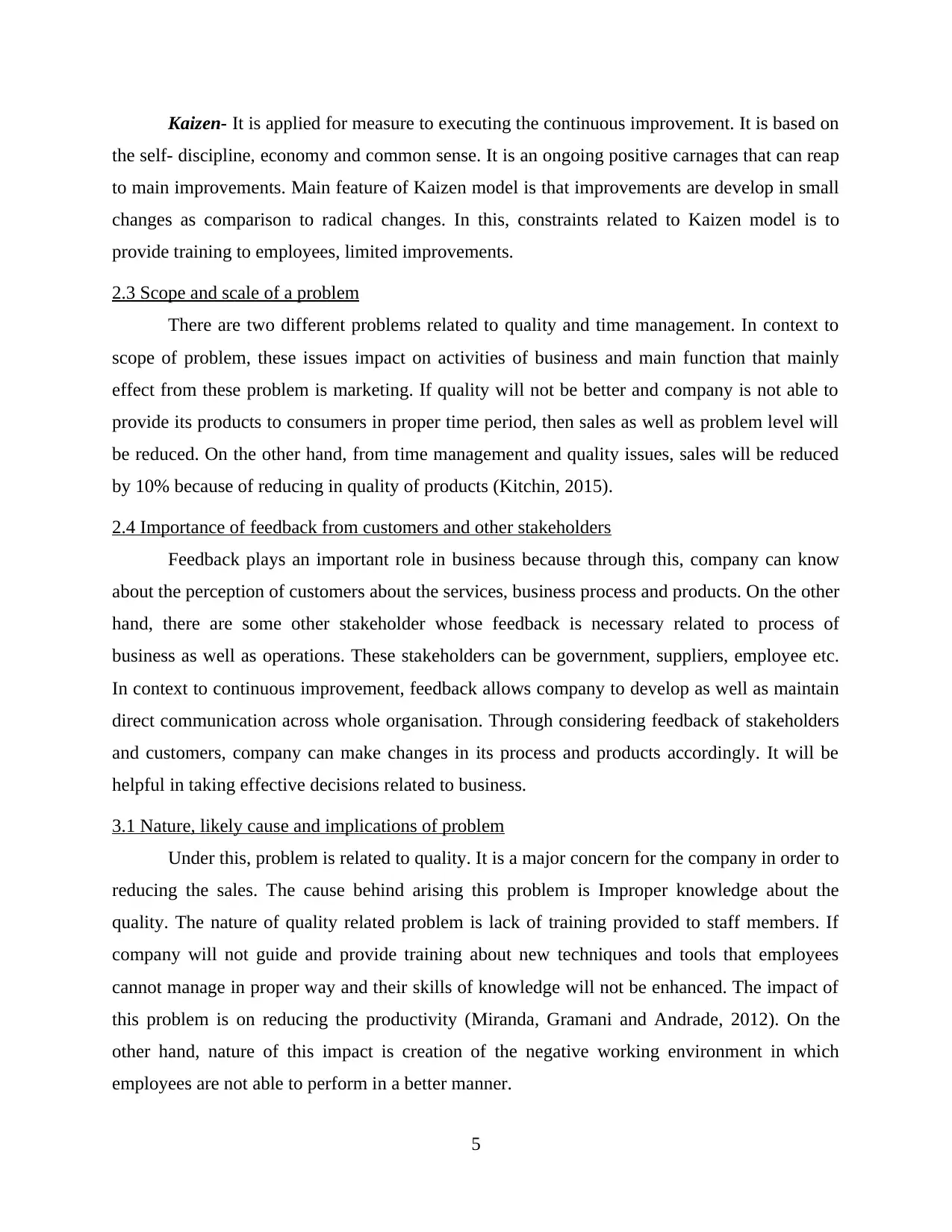
Kaizen- It is applied for measure to executing the continuous improvement. It is based on
the self- discipline, economy and common sense. It is an ongoing positive carnages that can reap
to main improvements. Main feature of Kaizen model is that improvements are develop in small
changes as comparison to radical changes. In this, constraints related to Kaizen model is to
provide training to employees, limited improvements.
2.3 Scope and scale of a problem
There are two different problems related to quality and time management. In context to
scope of problem, these issues impact on activities of business and main function that mainly
effect from these problem is marketing. If quality will not be better and company is not able to
provide its products to consumers in proper time period, then sales as well as problem level will
be reduced. On the other hand, from time management and quality issues, sales will be reduced
by 10% because of reducing in quality of products (Kitchin, 2015).
2.4 Importance of feedback from customers and other stakeholders
Feedback plays an important role in business because through this, company can know
about the perception of customers about the services, business process and products. On the other
hand, there are some other stakeholder whose feedback is necessary related to process of
business as well as operations. These stakeholders can be government, suppliers, employee etc.
In context to continuous improvement, feedback allows company to develop as well as maintain
direct communication across whole organisation. Through considering feedback of stakeholders
and customers, company can make changes in its process and products accordingly. It will be
helpful in taking effective decisions related to business.
3.1 Nature, likely cause and implications of problem
Under this, problem is related to quality. It is a major concern for the company in order to
reducing the sales. The cause behind arising this problem is Improper knowledge about the
quality. The nature of quality related problem is lack of training provided to staff members. If
company will not guide and provide training about new techniques and tools that employees
cannot manage in proper way and their skills of knowledge will not be enhanced. The impact of
this problem is on reducing the productivity (Miranda, Gramani and Andrade, 2012). On the
other hand, nature of this impact is creation of the negative working environment in which
employees are not able to perform in a better manner.
5
the self- discipline, economy and common sense. It is an ongoing positive carnages that can reap
to main improvements. Main feature of Kaizen model is that improvements are develop in small
changes as comparison to radical changes. In this, constraints related to Kaizen model is to
provide training to employees, limited improvements.
2.3 Scope and scale of a problem
There are two different problems related to quality and time management. In context to
scope of problem, these issues impact on activities of business and main function that mainly
effect from these problem is marketing. If quality will not be better and company is not able to
provide its products to consumers in proper time period, then sales as well as problem level will
be reduced. On the other hand, from time management and quality issues, sales will be reduced
by 10% because of reducing in quality of products (Kitchin, 2015).
2.4 Importance of feedback from customers and other stakeholders
Feedback plays an important role in business because through this, company can know
about the perception of customers about the services, business process and products. On the other
hand, there are some other stakeholder whose feedback is necessary related to process of
business as well as operations. These stakeholders can be government, suppliers, employee etc.
In context to continuous improvement, feedback allows company to develop as well as maintain
direct communication across whole organisation. Through considering feedback of stakeholders
and customers, company can make changes in its process and products accordingly. It will be
helpful in taking effective decisions related to business.
3.1 Nature, likely cause and implications of problem
Under this, problem is related to quality. It is a major concern for the company in order to
reducing the sales. The cause behind arising this problem is Improper knowledge about the
quality. The nature of quality related problem is lack of training provided to staff members. If
company will not guide and provide training about new techniques and tools that employees
cannot manage in proper way and their skills of knowledge will not be enhanced. The impact of
this problem is on reducing the productivity (Miranda, Gramani and Andrade, 2012). On the
other hand, nature of this impact is creation of the negative working environment in which
employees are not able to perform in a better manner.
5
Paraphrase This Document
Need a fresh take? Get an instant paraphrase of this document with our AI Paraphraser

3.3 Possible courses of action that can be taken in response to a problem
There is a main problem related to the quality. It is a main concern for an organisation as
well as consumers. In this modern era, consumers want high quality of products at the reasonable
cost. If the quality of product will not be better than in this case it can develop negative impact
on business. There is some possible course of action related to Quality issue mention below:
Company can adopt and implement the different tools of quality to improving in
production process and goods such as Continuous improvement, Six Sigma.
It can use the new and advanced technology in business.
Enhance knowledge, core competencies and skills of staff members.
3.4 Justify the approach to problem-solving
The approach related to problem solving is Creative approach. It is mental process for
developing solution related to problem. It is one of special form of the problem solving under
which solution is created independently rather than learn with an assistance. It needs more than
thinking as well as knowledge. In this, management make assumptions to solve the problems in a
better manner (Toth and Vigo, 2014). The main limitation of this problem is that there is no limit
to creative process. This approach of problem solving is helpful in execution of solution that will
help in overcoming from any kind of issues that arise at workplace. On the other hand, it is an
effective way to solve issues as well as determining opportunities in case conventional thinking
has to be failed.
3.5 Plan and success criteria that are appropriate to nature and scale of problem
In nature and scale of problem, company develop an effective plan by using the
Simulation. It is virtual medium by which employees can acquired different kinds of skills. It is
mainly used in business situations in context to make improvement in awareness of brand along
with the management skills. There is a plan related to stimulation mention below that is
appropriate to scale and nature of problem:
Creation of situation- There is need to create situation related to issues that can be
employees working under pressure, lack of training etc.
Engagement of employees- In this second step, management should engage its staff
members in implementing the solution of problem. It will be helpful in enhancing their morale.
Role distribution- Under this stage, company should distribute the role to employees on
the basis of their capabilities and competencies. From this, they will perform in a better manner.
6
There is a main problem related to the quality. It is a main concern for an organisation as
well as consumers. In this modern era, consumers want high quality of products at the reasonable
cost. If the quality of product will not be better than in this case it can develop negative impact
on business. There is some possible course of action related to Quality issue mention below:
Company can adopt and implement the different tools of quality to improving in
production process and goods such as Continuous improvement, Six Sigma.
It can use the new and advanced technology in business.
Enhance knowledge, core competencies and skills of staff members.
3.4 Justify the approach to problem-solving
The approach related to problem solving is Creative approach. It is mental process for
developing solution related to problem. It is one of special form of the problem solving under
which solution is created independently rather than learn with an assistance. It needs more than
thinking as well as knowledge. In this, management make assumptions to solve the problems in a
better manner (Toth and Vigo, 2014). The main limitation of this problem is that there is no limit
to creative process. This approach of problem solving is helpful in execution of solution that will
help in overcoming from any kind of issues that arise at workplace. On the other hand, it is an
effective way to solve issues as well as determining opportunities in case conventional thinking
has to be failed.
3.5 Plan and success criteria that are appropriate to nature and scale of problem
In nature and scale of problem, company develop an effective plan by using the
Simulation. It is virtual medium by which employees can acquired different kinds of skills. It is
mainly used in business situations in context to make improvement in awareness of brand along
with the management skills. There is a plan related to stimulation mention below that is
appropriate to scale and nature of problem:
Creation of situation- There is need to create situation related to issues that can be
employees working under pressure, lack of training etc.
Engagement of employees- In this second step, management should engage its staff
members in implementing the solution of problem. It will be helpful in enhancing their morale.
Role distribution- Under this stage, company should distribute the role to employees on
the basis of their capabilities and competencies. From this, they will perform in a better manner.
6
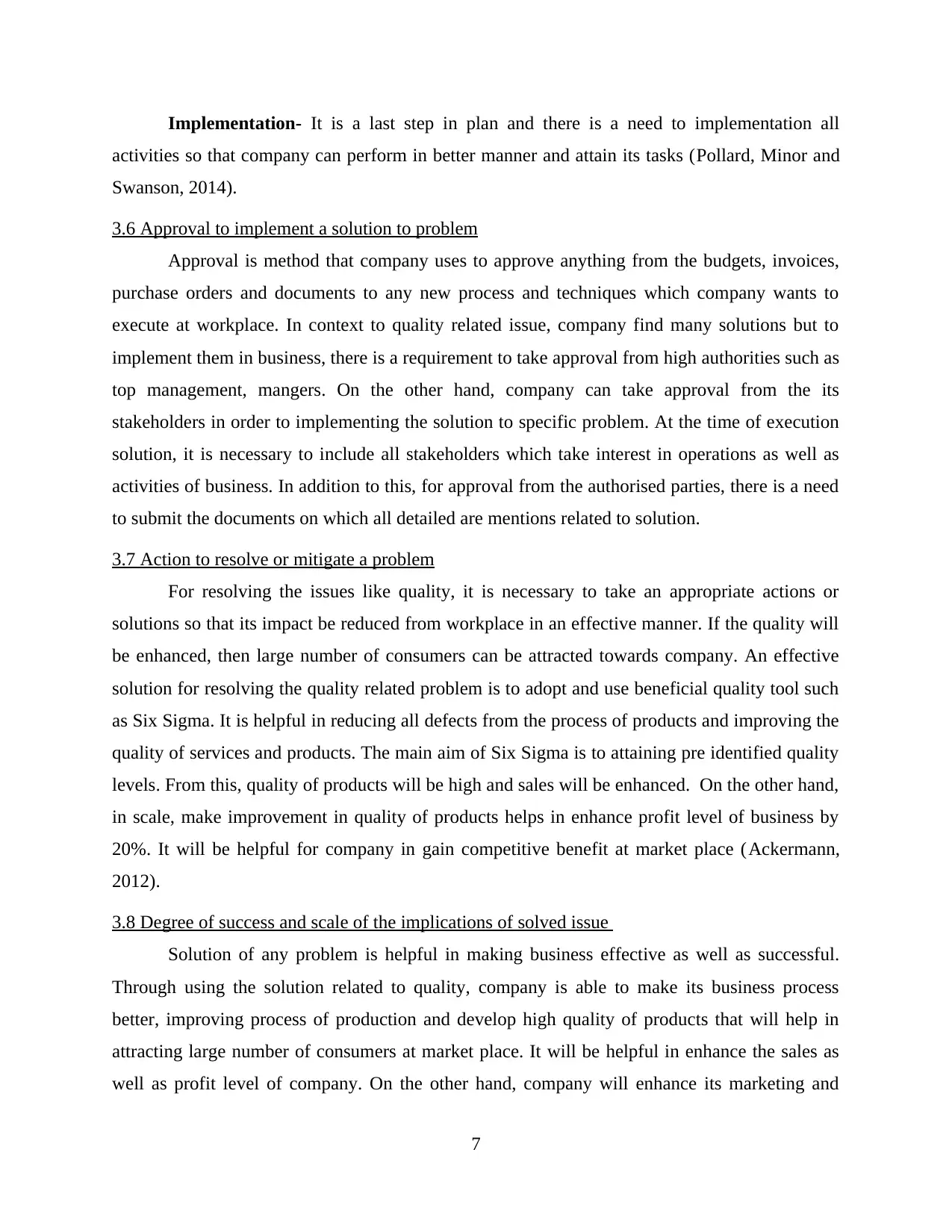
Implementation- It is a last step in plan and there is a need to implementation all
activities so that company can perform in better manner and attain its tasks (Pollard, Minor and
Swanson, 2014).
3.6 Approval to implement a solution to problem
Approval is method that company uses to approve anything from the budgets, invoices,
purchase orders and documents to any new process and techniques which company wants to
execute at workplace. In context to quality related issue, company find many solutions but to
implement them in business, there is a requirement to take approval from high authorities such as
top management, mangers. On the other hand, company can take approval from the its
stakeholders in order to implementing the solution to specific problem. At the time of execution
solution, it is necessary to include all stakeholders which take interest in operations as well as
activities of business. In addition to this, for approval from the authorised parties, there is a need
to submit the documents on which all detailed are mentions related to solution.
3.7 Action to resolve or mitigate a problem
For resolving the issues like quality, it is necessary to take an appropriate actions or
solutions so that its impact be reduced from workplace in an effective manner. If the quality will
be enhanced, then large number of consumers can be attracted towards company. An effective
solution for resolving the quality related problem is to adopt and use beneficial quality tool such
as Six Sigma. It is helpful in reducing all defects from the process of products and improving the
quality of services and products. The main aim of Six Sigma is to attaining pre identified quality
levels. From this, quality of products will be high and sales will be enhanced. On the other hand,
in scale, make improvement in quality of products helps in enhance profit level of business by
20%. It will be helpful for company in gain competitive benefit at market place (Ackermann,
2012).
3.8 Degree of success and scale of the implications of solved issue
Solution of any problem is helpful in making business effective as well as successful.
Through using the solution related to quality, company is able to make its business process
better, improving process of production and develop high quality of products that will help in
attracting large number of consumers at market place. It will be helpful in enhance the sales as
well as profit level of company. On the other hand, company will enhance its marketing and
7
activities so that company can perform in better manner and attain its tasks (Pollard, Minor and
Swanson, 2014).
3.6 Approval to implement a solution to problem
Approval is method that company uses to approve anything from the budgets, invoices,
purchase orders and documents to any new process and techniques which company wants to
execute at workplace. In context to quality related issue, company find many solutions but to
implement them in business, there is a requirement to take approval from high authorities such as
top management, mangers. On the other hand, company can take approval from the its
stakeholders in order to implementing the solution to specific problem. At the time of execution
solution, it is necessary to include all stakeholders which take interest in operations as well as
activities of business. In addition to this, for approval from the authorised parties, there is a need
to submit the documents on which all detailed are mentions related to solution.
3.7 Action to resolve or mitigate a problem
For resolving the issues like quality, it is necessary to take an appropriate actions or
solutions so that its impact be reduced from workplace in an effective manner. If the quality will
be enhanced, then large number of consumers can be attracted towards company. An effective
solution for resolving the quality related problem is to adopt and use beneficial quality tool such
as Six Sigma. It is helpful in reducing all defects from the process of products and improving the
quality of services and products. The main aim of Six Sigma is to attaining pre identified quality
levels. From this, quality of products will be high and sales will be enhanced. On the other hand,
in scale, make improvement in quality of products helps in enhance profit level of business by
20%. It will be helpful for company in gain competitive benefit at market place (Ackermann,
2012).
3.8 Degree of success and scale of the implications of solved issue
Solution of any problem is helpful in making business effective as well as successful.
Through using the solution related to quality, company is able to make its business process
better, improving process of production and develop high quality of products that will help in
attracting large number of consumers at market place. It will be helpful in enhance the sales as
well as profit level of company. On the other hand, company will enhance its marketing and
7
⊘ This is a preview!⊘
Do you want full access?
Subscribe today to unlock all pages.

Trusted by 1+ million students worldwide
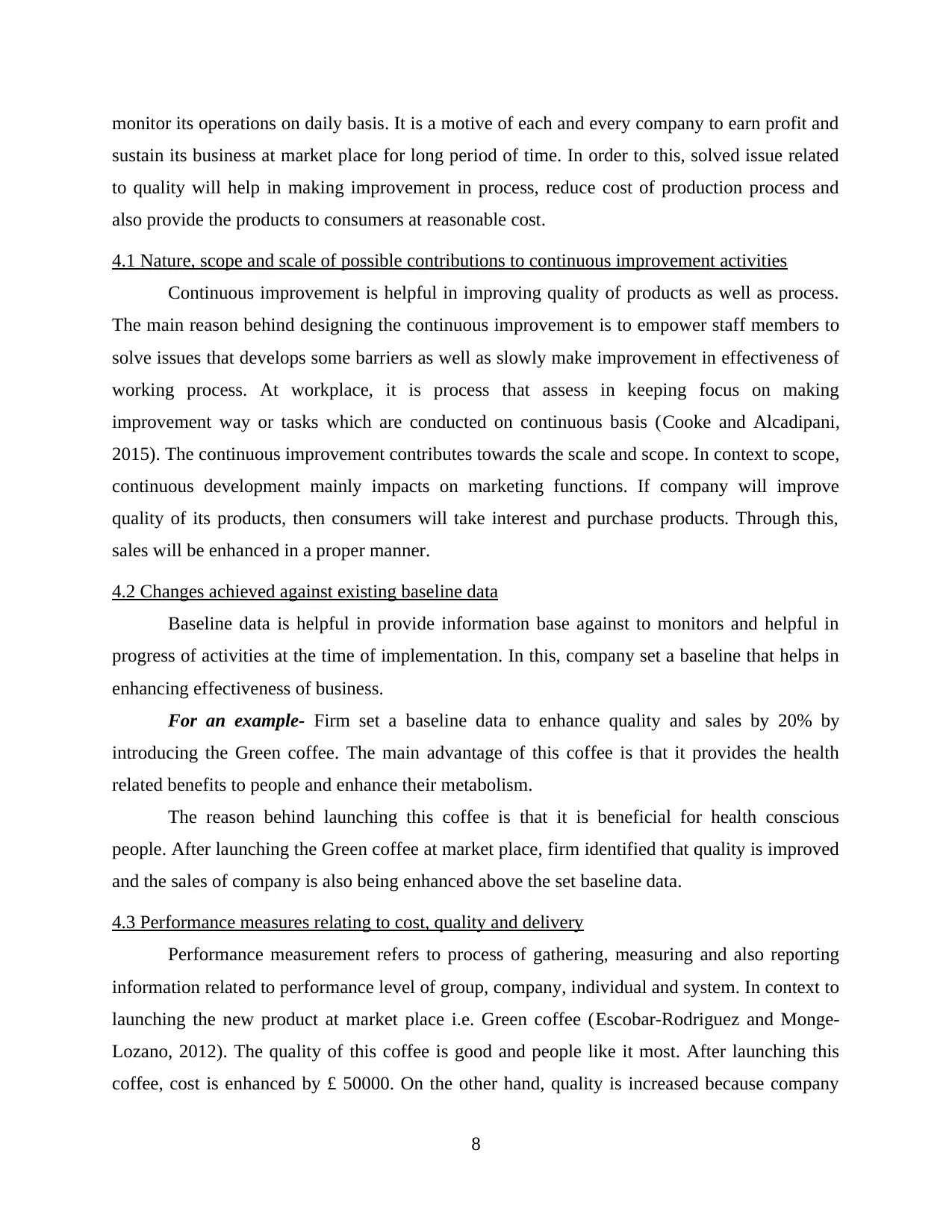
monitor its operations on daily basis. It is a motive of each and every company to earn profit and
sustain its business at market place for long period of time. In order to this, solved issue related
to quality will help in making improvement in process, reduce cost of production process and
also provide the products to consumers at reasonable cost.
4.1 Nature, scope and scale of possible contributions to continuous improvement activities
Continuous improvement is helpful in improving quality of products as well as process.
The main reason behind designing the continuous improvement is to empower staff members to
solve issues that develops some barriers as well as slowly make improvement in effectiveness of
working process. At workplace, it is process that assess in keeping focus on making
improvement way or tasks which are conducted on continuous basis (Cooke and Alcadipani,
2015). The continuous improvement contributes towards the scale and scope. In context to scope,
continuous development mainly impacts on marketing functions. If company will improve
quality of its products, then consumers will take interest and purchase products. Through this,
sales will be enhanced in a proper manner.
4.2 Changes achieved against existing baseline data
Baseline data is helpful in provide information base against to monitors and helpful in
progress of activities at the time of implementation. In this, company set a baseline that helps in
enhancing effectiveness of business.
For an example- Firm set a baseline data to enhance quality and sales by 20% by
introducing the Green coffee. The main advantage of this coffee is that it provides the health
related benefits to people and enhance their metabolism.
The reason behind launching this coffee is that it is beneficial for health conscious
people. After launching the Green coffee at market place, firm identified that quality is improved
and the sales of company is also being enhanced above the set baseline data.
4.3 Performance measures relating to cost, quality and delivery
Performance measurement refers to process of gathering, measuring and also reporting
information related to performance level of group, company, individual and system. In context to
launching the new product at market place i.e. Green coffee (Escobar-Rodriguez and Monge-
Lozano, 2012). The quality of this coffee is good and people like it most. After launching this
coffee, cost is enhanced by £ 50000. On the other hand, quality is increased because company
8
sustain its business at market place for long period of time. In order to this, solved issue related
to quality will help in making improvement in process, reduce cost of production process and
also provide the products to consumers at reasonable cost.
4.1 Nature, scope and scale of possible contributions to continuous improvement activities
Continuous improvement is helpful in improving quality of products as well as process.
The main reason behind designing the continuous improvement is to empower staff members to
solve issues that develops some barriers as well as slowly make improvement in effectiveness of
working process. At workplace, it is process that assess in keeping focus on making
improvement way or tasks which are conducted on continuous basis (Cooke and Alcadipani,
2015). The continuous improvement contributes towards the scale and scope. In context to scope,
continuous development mainly impacts on marketing functions. If company will improve
quality of its products, then consumers will take interest and purchase products. Through this,
sales will be enhanced in a proper manner.
4.2 Changes achieved against existing baseline data
Baseline data is helpful in provide information base against to monitors and helpful in
progress of activities at the time of implementation. In this, company set a baseline that helps in
enhancing effectiveness of business.
For an example- Firm set a baseline data to enhance quality and sales by 20% by
introducing the Green coffee. The main advantage of this coffee is that it provides the health
related benefits to people and enhance their metabolism.
The reason behind launching this coffee is that it is beneficial for health conscious
people. After launching the Green coffee at market place, firm identified that quality is improved
and the sales of company is also being enhanced above the set baseline data.
4.3 Performance measures relating to cost, quality and delivery
Performance measurement refers to process of gathering, measuring and also reporting
information related to performance level of group, company, individual and system. In context to
launching the new product at market place i.e. Green coffee (Escobar-Rodriguez and Monge-
Lozano, 2012). The quality of this coffee is good and people like it most. After launching this
coffee, cost is enhanced by £ 50000. On the other hand, quality is increased because company
8
Paraphrase This Document
Need a fresh take? Get an instant paraphrase of this document with our AI Paraphraser
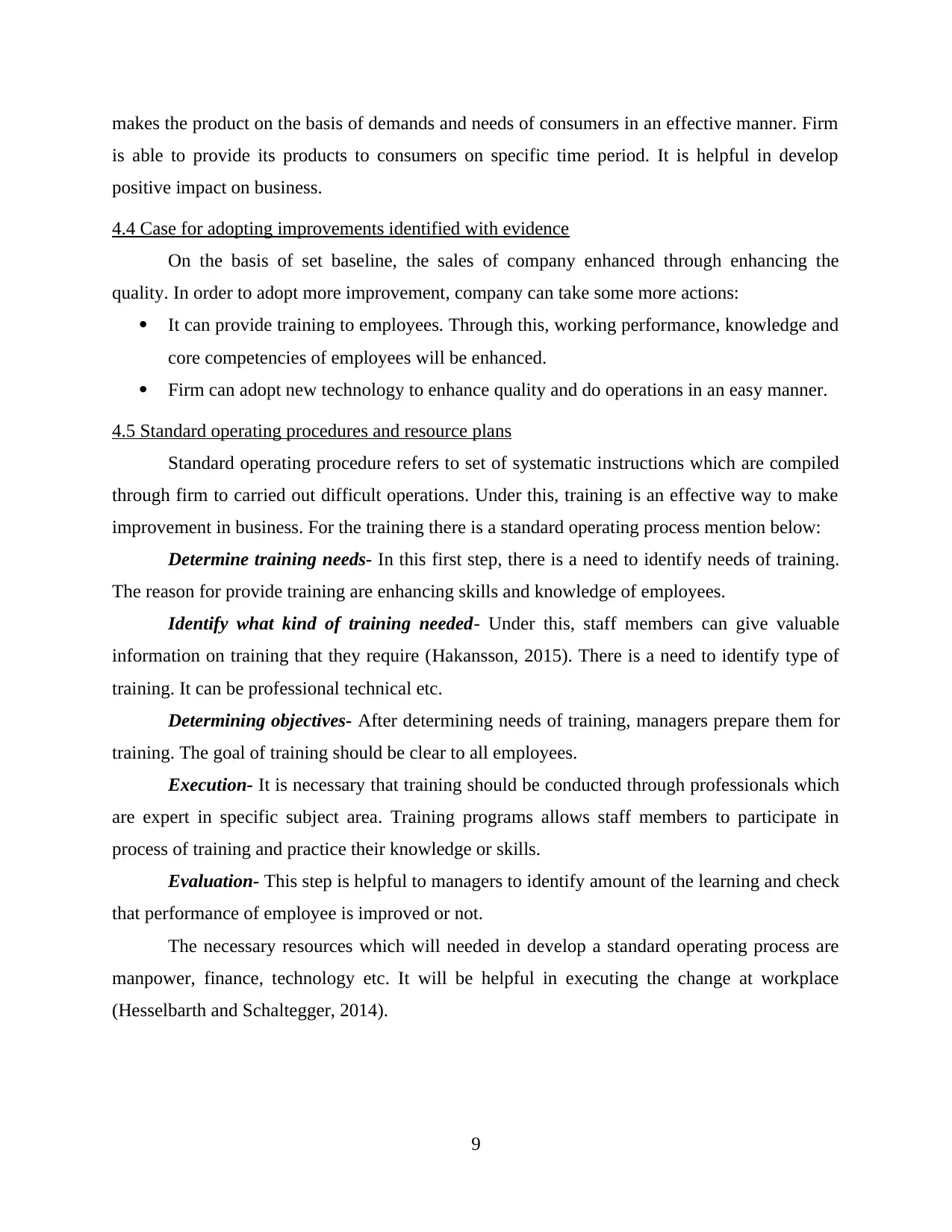
makes the product on the basis of demands and needs of consumers in an effective manner. Firm
is able to provide its products to consumers on specific time period. It is helpful in develop
positive impact on business.
4.4 Case for adopting improvements identified with evidence
On the basis of set baseline, the sales of company enhanced through enhancing the
quality. In order to adopt more improvement, company can take some more actions:
It can provide training to employees. Through this, working performance, knowledge and
core competencies of employees will be enhanced.
Firm can adopt new technology to enhance quality and do operations in an easy manner.
4.5 Standard operating procedures and resource plans
Standard operating procedure refers to set of systematic instructions which are compiled
through firm to carried out difficult operations. Under this, training is an effective way to make
improvement in business. For the training there is a standard operating process mention below:
Determine training needs- In this first step, there is a need to identify needs of training.
The reason for provide training are enhancing skills and knowledge of employees.
Identify what kind of training needed- Under this, staff members can give valuable
information on training that they require (Hakansson, 2015). There is a need to identify type of
training. It can be professional technical etc.
Determining objectives- After determining needs of training, managers prepare them for
training. The goal of training should be clear to all employees.
Execution- It is necessary that training should be conducted through professionals which
are expert in specific subject area. Training programs allows staff members to participate in
process of training and practice their knowledge or skills.
Evaluation- This step is helpful to managers to identify amount of the learning and check
that performance of employee is improved or not.
The necessary resources which will needed in develop a standard operating process are
manpower, finance, technology etc. It will be helpful in executing the change at workplace
(Hesselbarth and Schaltegger, 2014).
9
is able to provide its products to consumers on specific time period. It is helpful in develop
positive impact on business.
4.4 Case for adopting improvements identified with evidence
On the basis of set baseline, the sales of company enhanced through enhancing the
quality. In order to adopt more improvement, company can take some more actions:
It can provide training to employees. Through this, working performance, knowledge and
core competencies of employees will be enhanced.
Firm can adopt new technology to enhance quality and do operations in an easy manner.
4.5 Standard operating procedures and resource plans
Standard operating procedure refers to set of systematic instructions which are compiled
through firm to carried out difficult operations. Under this, training is an effective way to make
improvement in business. For the training there is a standard operating process mention below:
Determine training needs- In this first step, there is a need to identify needs of training.
The reason for provide training are enhancing skills and knowledge of employees.
Identify what kind of training needed- Under this, staff members can give valuable
information on training that they require (Hakansson, 2015). There is a need to identify type of
training. It can be professional technical etc.
Determining objectives- After determining needs of training, managers prepare them for
training. The goal of training should be clear to all employees.
Execution- It is necessary that training should be conducted through professionals which
are expert in specific subject area. Training programs allows staff members to participate in
process of training and practice their knowledge or skills.
Evaluation- This step is helpful to managers to identify amount of the learning and check
that performance of employee is improved or not.
The necessary resources which will needed in develop a standard operating process are
manpower, finance, technology etc. It will be helpful in executing the change at workplace
(Hesselbarth and Schaltegger, 2014).
9

CONCLUSION
It has been concluded from above mention report that business administration is helpful
in supervising the business operations of any field in an organisation. In order to resolve the
issues, organisations use different problem solving techniques such as brain storming, analytical
etc. There has been discuss about the possible course of action to response to issue.
10
It has been concluded from above mention report that business administration is helpful
in supervising the business operations of any field in an organisation. In order to resolve the
issues, organisations use different problem solving techniques such as brain storming, analytical
etc. There has been discuss about the possible course of action to response to issue.
10
⊘ This is a preview!⊘
Do you want full access?
Subscribe today to unlock all pages.

Trusted by 1+ million students worldwide
1 out of 13
Related Documents
Your All-in-One AI-Powered Toolkit for Academic Success.
+13062052269
info@desklib.com
Available 24*7 on WhatsApp / Email
![[object Object]](/_next/static/media/star-bottom.7253800d.svg)
Unlock your academic potential
Copyright © 2020–2025 A2Z Services. All Rights Reserved. Developed and managed by ZUCOL.





